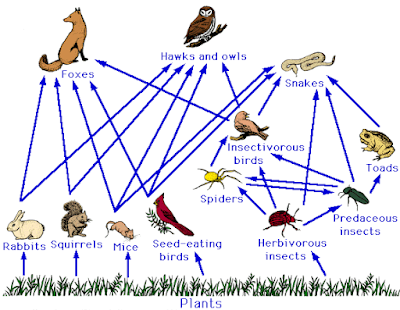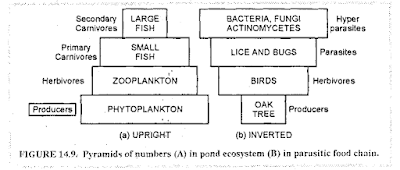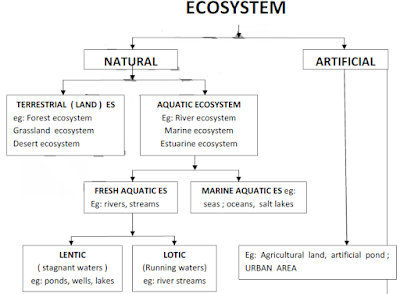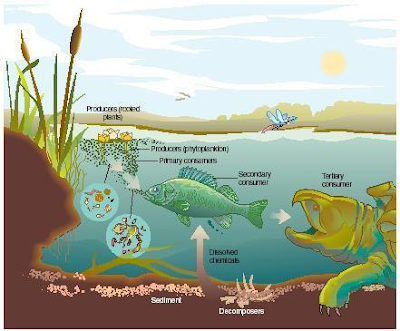${tocify}
FOOD CHAIN
In food chain each organism eats the smaller organisms and is eaten by the larger one. All those organisms which are interlinked with each other through food to gather constitute the ecosystem.
The different levels in a food chain are called tropic levels, Each food chain has three main tropic levels:- Producer level, Consumer level, and decomposer level. If any of the intermediate stage of the food chain is removed, the succeeding links of the food chain will be affected.
Types of Food Chains
a) Grazing Food Chain: This type of food chain starts from living green plants goes to grazing herbivores and onto carnivores. Ecosystem with such type of food chain directly depends upon the solar energy for their food requirements. Most of the ecosystem in nature follows this type of food chain.
b) Detritus food Chain: This type of food chain goes from dead organic matter onto microorganisms and then to the organisms feeding on detritus and their predators. Such ecosystems are less dependent on direct solar energy.
c) Parasitic Food Chain: This type of food chain starts from big hosts and ends with parasitic organisms
FOOD WEB
The interconnected, interlocking pattern of food chain is known as food web. Under natural condition of the linear arrangement of food chain hardly occurs and they remain interconnected with each other through different types of organisms at different levels Such a interconnected and interlocking pattern of food chain is known as food web.
ECOLOGICAL PYRAMIDS
The different species in a food chain are called tropic levels. Each food chain has 3 main trophic level, producer, consumer, and decomposers. Thus Graphical representation of these trophic levels is called as Ecological Pyramids. It was devised by an ecologist “Charles Elton” therefore this pyramid are also called Ecological pyramid or Eltonian pyramids.
Types of Ecological Pyramids
Ecological pyramids are of three types:
I) Pyramid of Number
II)Pyramid of biomass
III) Pyramid of Energy
I) Pyramid of Number
They show the relationship between producers, herbivores, and carnivores at successive tropic levels in terms of their number.
In case of pond ecosystem the producers are mainly phytoplankton and are always maximum in number this number then shows a decrease towards apex as primary consumers are zooplanktons are lesser in number than phytoplankton, the secondary consumers are large fish are even lesser in number than the phytoplankton. Thus the shape of pyramid is upright. But in case of forest ecosystem the pyramids is always inverted because the producers are mainly large trees, are lesser in numbers, the herbivores fruit eating birds are more in number than the producers, then there is gradual decrease in number of secondary consumers thus making pyramid upright again. Thus the pyramid of number does not give a true picture of the food chain and are not very functional.
II) Pyramid of Biomass
The pyramid of biomass represents the relationship between different tropic levels in terms of biomass. There is generally gradual decrease in biomass of organisms at successive levels from the producers to the top carnivores. Thus pyramid of biomass is upright for grassland ecosystem. However in case of a pond as the producers are algae, are least in number and this value gradually shows an increase towards the apex of pyramid thus making the pyramid inverted in shape.
III) Pyramid of Energy
Of the 3 types of ecological pyramid the energy pyramid gives the best picture of overall nature of the ecosystem. In this type of pyramid the tropic level is decided depending upon the rate at which food is being produced. In shape it is always upright as in most of the cases there is always gradual decrease in the energy content at successive trophic level from producers to various consumers.
CLASSIFICATION OF ECOSYSTEMS
Due to the abiotic factors, different ecosystems develop in different ways. These factors and their interaction between each other and with biotic components have resulted in formation of different types of ecosystems as explained below.
Ecosystem may be natural or artificial.
Artificial Ecosystem
These are maintained or created artificially by man. The man tries to control biotic community as well as physico-chemical environment. Eg: Artificial pond, urban area development.
Natural Ecosystem
It consists of Terrestrial and Aquatic Ecosystems which are maintained naturally.
Different Types of Ecosystem of Biosphere Artificially Categorized
I) Natural Ecosystems
These ecosystems operate by themselves under natural conditions without any major interference by man. Based upon the particular kind of habitat, these are further divided as:
• Terrestrial as forest, grassland, desert etc.
• Aquatic which may be further distinguished as - Freshwater which may be lotic (running water as springs, stream, river) or lentic (standing water as lake, pond, pools, ditch, swamps, etc.)
• Marine Ecosystems: as an ocean or shallow ones like sea or estuary etc.
II) Artificial Ecosystems
These are maintained by man where, by addition of energy & planned manipulations natural balance is disturbed regularly. For eg : croplands like maize, wheat, rice-fields etc., where man tries to control the biotic community as well as physico-chemical environment are artificial ecosystems
Pond Ecosystem
A Pond as a whole serves a good example of freshwater ecosystem.
Abiotic Components
The chief components are heat, light, pH of water, CO2, oxygen, calcium, nitrogen, phosphates, etc.
Biotic Components
The various organization that constitute the biotic component are as follows,
• Producers: These are green plants, and some photosynthetic bacteria. The producer fix radiant energy and convert it into organic substances as carbohydrates, protein etc
• Macrophytes: these are large rooted plants, which include partly or completely submerged hydrophytes, eg Hydrilla, Trapha, Typha.
• Phytoplankton: These are minute floating or submerged lower plants eg algae.
• Consumers: They are heterotrophs which depend for their nutrition on the organic food manufactured by producers.
• Primary Consumers: – Benthos: These are animals associated with living plants, detrivores and some other microorganisms –Zooplanktons: These are chiefly rotifers, protozoans, they feed on phytoplankton
• Secondary Consumers: They are the Carnivores which feed on herbivores, these are chiefly insect and fish, most insects & water beetles, they feed on zooplanktons.
• Tertiary Consumers: These are some large fish as game fish, turtles, which feed on small fish and thus become tertiary consumers.
• Decomposers: They are also known as microconsumers. They decompose dead organic matter of both producers and animal to simple form. Thus they play an important role in the return of minerals again to the pond ecosystem, they are chiefly bacteria, & fungi.
Ocean Ecosystem
Ocean ecosystem are more stable than pond ecosystem, they occupy 70 % of the earth surface.
Abiotic Components
Dissolved oxygen, light, temperature, minerals.
Biotic Components
• Producers: These are autotrophs and are also known Primary producers. They are mainly, some microscopic algae (phyto-planlanktons) besides them there are mainly, seaweeds, as brown and red algae also contribute to primary production.
• Consumers: They are all heterotrophic macro consumers
• Primary Consumer: The herbivores, that feed on producers are shrimps, Molluscs, fish, etc.
• Secondary Consumers: These are carnivores fish as Herring, Shad, Mackerel, feeding on herbivores.
• Tertiary Consumers: These includes, other carnivores fishes like, COD, Halibut, Sea Turtle, Sharks etc.
• Decomposers: The microbes active in the decay of dead organic matter of producers, and animals are chiefly, bacteria and some fungi.
Estuarine Ecosystem
An estuary is a partially enclosed body of water along the coast where fresh water from river and streams meet and mix with salt water from oceans. These Ecosystems are considered as most fertile ecosystem.
Abiotic Components
Nutrients such as phosphorus and nitrogen, temperature, light, salinity, pH. This ecosystem experience wide daily and seasonal fluctuations in temperature and Salinity level because of variation in freshwater in flow.
Biotic Components
• Producers: Phyplanktons- these micro-organisms manufacture food by photosynthesis and absorb nutrients such as phosphorous and nitrogen, besides them, mangroves, sea grass, weeds, and salt marshes.
• Consumers: Primary consumers, Zooplanktons that feed on Phytoplankton, besides them some small microorganisms that feed on producers.
• Secondary Consumer: Include worms, shellfish, small fish, feeding on Zooplanktons
• Tertiary Consumer: Fishes, turtles, crabs, starfishes feeding on secondary consumers.
• Decomposers: Fungi & Bacteria are the chief microbes active in decay of dead organic matter.
River Ecosystem
As Compared with lentic freshwater (Ponds & lakes), lotic waters such as streams, and river have been less studied. However, the various components of an riverine and stream ecosystem can be arranged as follows.
• Producers: The chief producers that remain permanently attached to a firm substratum are green algae as Cladophora, and aquatic mosses.
• Consumers: The consumers show certain features as permanent attachment to firm substrata, presence of hooks & suckers, sticky undersurface, streamline bodies, flattened bodies.. Thus a variety of animal are found, which are fresh spongy and caddis-fly larvae, snails, flat worms etc.
• Decomposers: Various bacteria and fungi like actinomycetes are present which acts as decompose.











